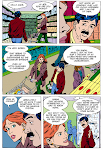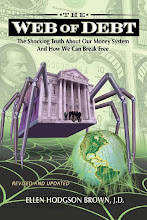http://neweconomics.org/blog/2010/09/28/democratizing-money
Huomaa että otsikko viittaa rahan demokratisointiin. Tämä tietysti tarkoittaa sitä että paheksutaan tämän päivän oligarkista rahavaltajärjestelmää. Oligarkia tarkoittaa suomeksi harvainvalta. Demokratia vuorostaan tarkoittaa kansanvaltaa - rahavallan eli talousvallan demokratisointi on talousdemokratia.
Tätä samaa "rahavallan demokratiosintia "vaaditaan kaikkialla maailmassa missä on valistuneita ihmisiä - vaikkemme välttämättä tiedä siitä....vielä.
Tässä kuva linkin avaamasta sivustosta:

Poiminta englanninkielisestä tekstistä:
How does fractional reserve banking work? When you put £100 in the bank a strange thing happens. The bank holds on to a ‘fraction’ of your deposit (say 1/10th) and lends the remainder out, charging interest upon it. This £90 loan is described as an ‘asset’ by the bank – it has created it, as if by magic. It charges interest upon the loan and it must be repaid by the debtor with the interest or they will commit a criminal offence. The debtor pays the £90 in to another bank who can then loan out £81, again at interest. The process goes on and on and eventually through this ‘money multiplier’ process, £987 of completely new debt-money is created.
This capacity of banks to create money on the basis of maintaining very small fractions of deposits is one of the most important elements of modern capitalism. Indeed the great German economist Joseph Schumpeter believed it to be the distinguishing feature of capitalism from all previous economic systems. It certainly helps us to explain the astonishing pace of growth we have seen in the Western world (where this system is most developed) over the past 200 years.
It has become clear, however, that our economies cannot keep on growing at the exponential rate we have seen over the past two centuries. Even if we weren’t facing disastrous climate change, there simply isn’t enough cheap oil to maintain such levels. As economist Herman Daly puts it, fractional reserve banking is not growth neutral, but a ‘growth pusher’:
“…For all those loans to be paid back with interest the borrower must make the money grow by a rate at least as high as the rate of interest… The result is that economic growth is required just to keep the money supply from shrinking as old loans are repaid.” (Daly, H., 1999: 133).
Daly’s quote also points to the inherent instability of our financial system. If virtually all the money in circulation is created as debt by banks then money is effectively, credit (or debt). The problem is that if debtors default on their debt (as with the sub-prime crisis), or, indeed, all suddenly choose to pay off their debts and stop borrowing, suddenly the magical ‘multiplier’ goes in to reverse. This is exactly what is happening now across the western world following the recession. People are tightening their belts, concerned about their jobs. They’ve stopped borrowing, whether it be for holidays, cars or, most importantly in the UK, homes. As a result, the money supply is shrinking.




2 kommenttia:
Jos ei ole tulostinta, niin onko kannattajakortti mahdollista täyttää netin kautta?
Oikeusministeriö vaatii paperiset kannattajakortit joiden koko on A6 ja paksuus 120 g/m2
Me olemme poikkeusluvalla saaneet luvan neuvoa kiinnostuneita tulostamaan ladatun kortin oman tulostimen 80g/m2-paperille.
Kortin voi toki imuroida ja tallentaa omalle koneelle - ja siirtää toiselle koneelle missä on tulostin, joko USB-muistitikulla tai sähköpostin liitteenä.
Lähetä kommentti